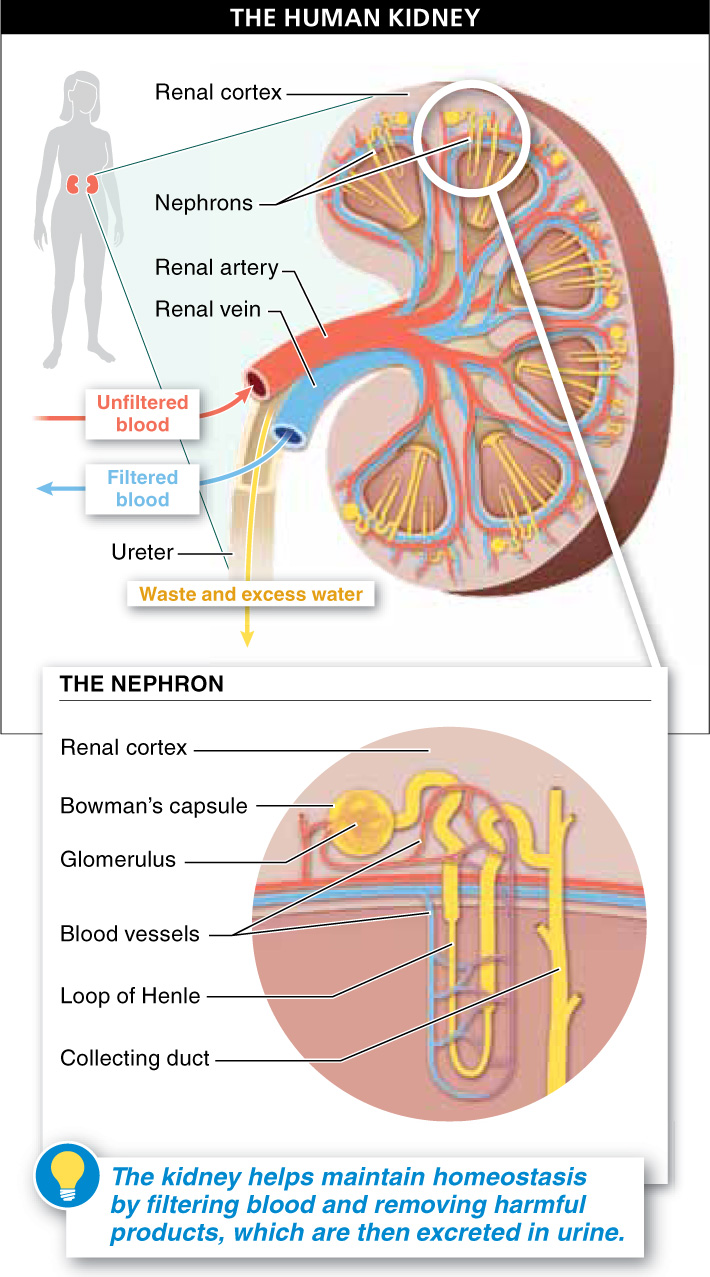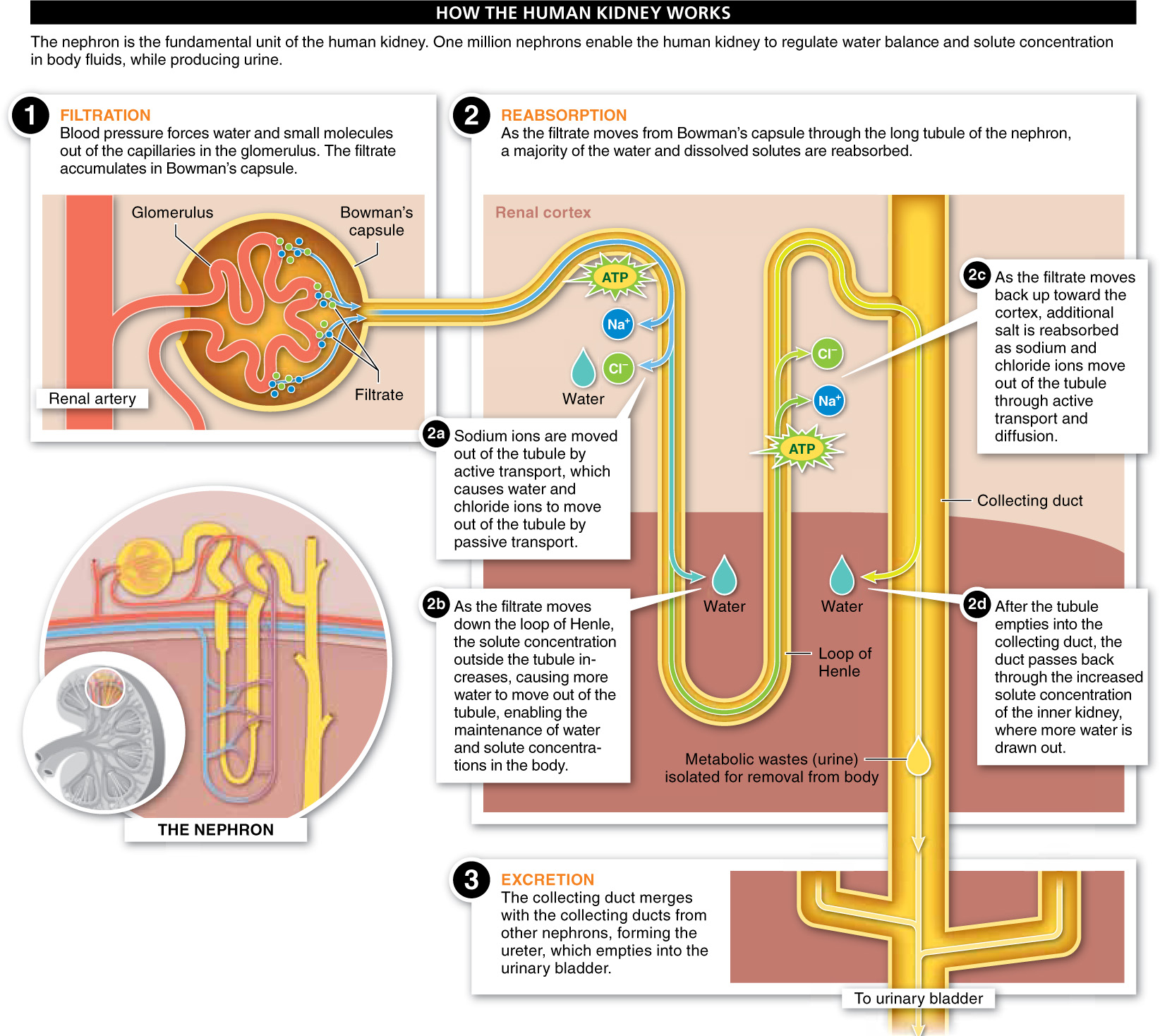
The kidney is an organ in vertebrates that helps maintain homeostasis by regulating water balance and solute concentration in body fluids. It accomplishes this by filtering blood—
- 1. Filtration. As blood passes through the kidneys, it is filtered. During this process, water, ions, and other dissolved substances are removed from the blood as a filtrate, leaving behind just cells and large proteins.
- 2. Reabsorption. The filtrate is then processed and modified, as water, nutrients (including glucose and amino acids), and some ions are reabsorbed into the blood, concentrating the filtrate.
- 3. Secretion. Following concentration of the filtrate, the substances not needed by the body are excreted in the urine.
The amount of urine excreted each day depends on an individual’s fluid intake and water loss (such as due to perspiration) and typically ranges from 0.7 to 2.0 liters. In controlling the amount of water excreted in urine or reabsorbed, the kidneys play an important role in preventing dehydration, even as fluid consumption and fluid loss may vary tremendously from day to day.
The filtering of blood by the kidneys begins as blood flows into blood vessels within each kidney via a renal artery. The filtered blood leaves the kidney via a renal vein, while waste products isolated during filtration and any excess water removed from the bloodstream pass to the bladder, and from there are excreted as urine (FIGURE 20-24).
A human has two kidneys, each about the size of a fist, located on either side of the spine, just above the waist. Each kidney is made up of approximately a million nephrons, the structural units that accomplish the work of the kidneys. A nephron consists of two basic components: a nephron tubule and a mass of blood vessels that work together to accomplish the tasks of filtration, reabsorption, and secretion (FIGURE 20-25). The blood-

The capillaries in the glomerulus are porous, and blood pressure forces out water and small molecules and ions (but not blood cells or most proteins) through the capillary walls. Fluid that accumulates in Bowman’s capsule, called filtrate, contains salts, sugars, amino acids, vitamins, and many other molecules, all at the same concentration as in the blood.
818
As the filtrate moves from Bowman’s capsule through the urine-
Reabsorption in the long tubule of the nephron is a complex process. It begins with the active transport of sodium ions out of the tubule, which causes water and chloride ions to follow, moving out by passive transport.
The tubule (and the filtrate it contains) then loops from the outer part of the kidney, called the cortex (see Figure 20-24), down into the innermost part of the kidney and back again, in a path called the loop of Henle. As the tubule passes to the innermost part of the kidney, it encounters a higher solute concentration in the interstitial fluid, outside the tube. This creates an osmotic gradient, which causes more and more water to be drawn out of the tubule, moving from the filtrate into the interstitial fluid.
819
Then, as the filtrate moves up toward the kidney cortex again, more salt is lost, through diffusion and active transport. In the cortex, the tubule empties into the collecting duct, which passes through the innermost part of the kidney again, returning additional water to the interstitial fluid and further concentrating the urine for excretion. The collecting duct eventually merges with collecting ducts from other nephrons, ultimately forming the ureter, which empties into the urinary bladder. From the bladder, urine passes through the urethra and is excreted from the body.
Why do some desert mammals never need to drink water?
Filtering the blood and producing urine not only follows a complicated path but is very energetically expensive. Considerable amounts of energy are expended in the active transport of solutes that leads to the recovery of water. Nonetheless, some animals, such as kangaroo rats, are so efficient at reabsorbing water that they never have to drink water at all. They can recover nearly all of the water filtered by their kidneys so that the water contained in their food and generated as a by-

Nitrogen-
How can some drugs be detected by urinalysis even months after the last intake?
The human kidneys are so effective at filtering blood and concentrating the many waste products of metabolism in urine that it is possible to detect the use of many drugs through urinalysis. Most drug-
TAKE-HOME MESSAGE 20.13
The kidney is the organ in vertebrates that helps maintain homeostasis by regulating water balance and solute concentrations in body fluids, filtering blood, and removing potentially harmful ions and metabolic waste products, excreting them in the urine.
Filtration is the process by which blood pressure forces water and solute molecules from capillaries of the glomerulus into the Bowman's capsule. Describe the next two events that occur in a kidney's nephron as it regulates the composition of blood.
The reabsorption of water and useful solute molecules occurs as this filtrate moves from the Bowman's capsule through the long tubule of the nephron, leaving various waste materials within this tubule. Excretion occurs where these tubules merge with those of other nephrons, forming the ureter, which empties this waste into the urinary bladder.
820